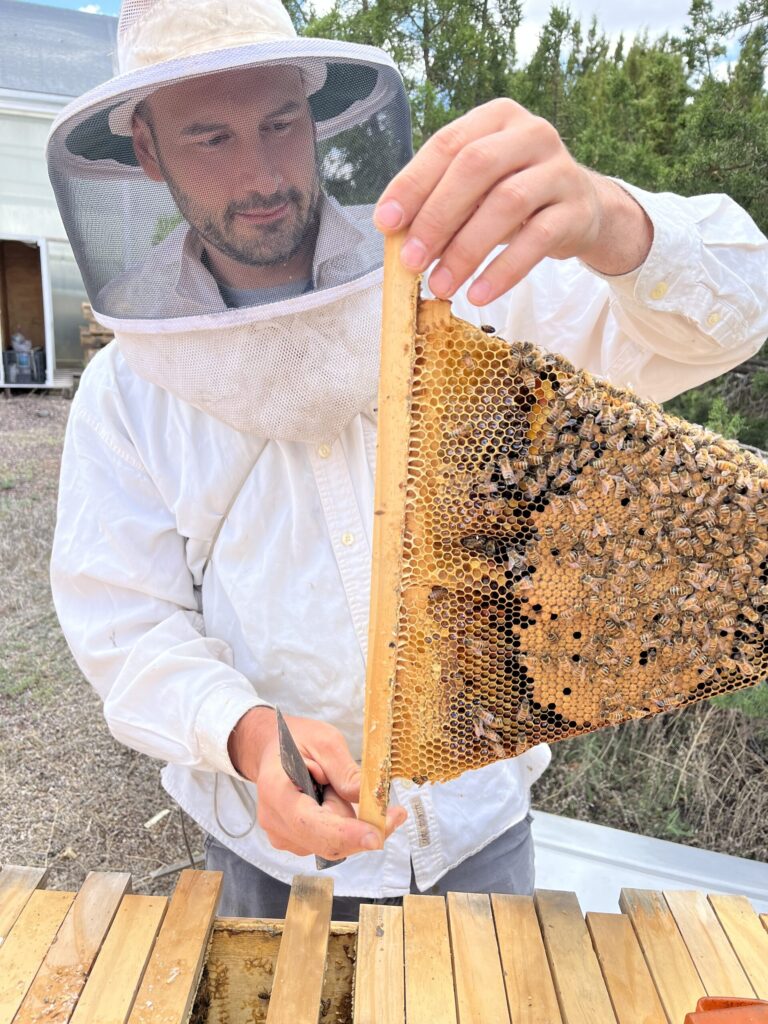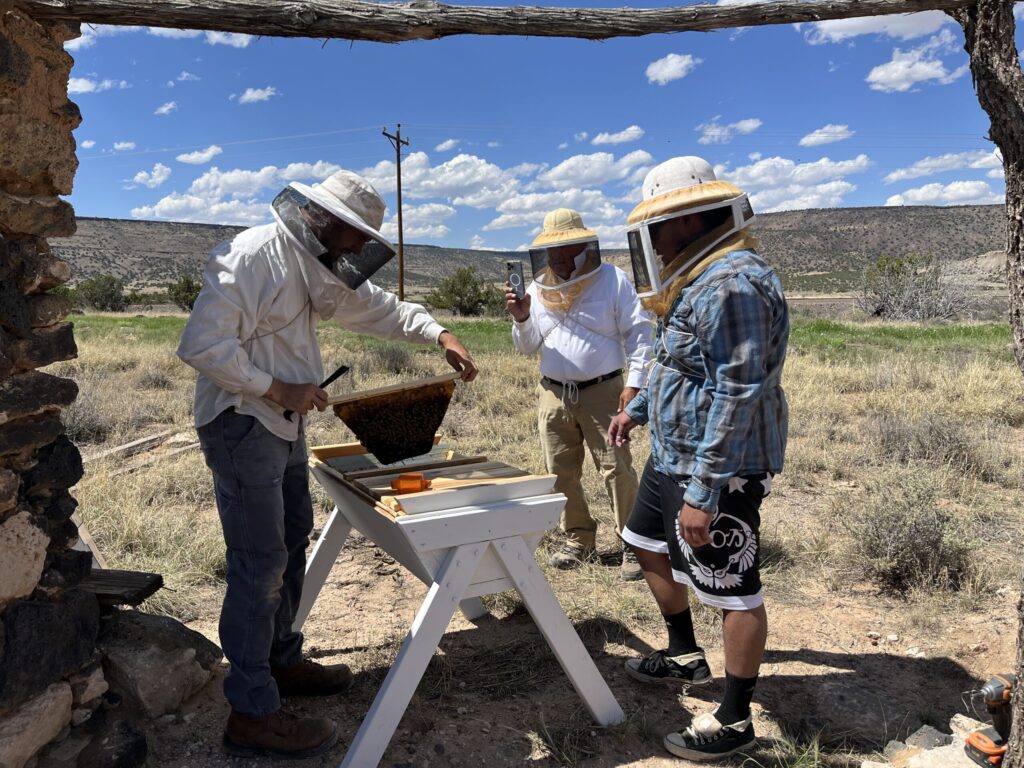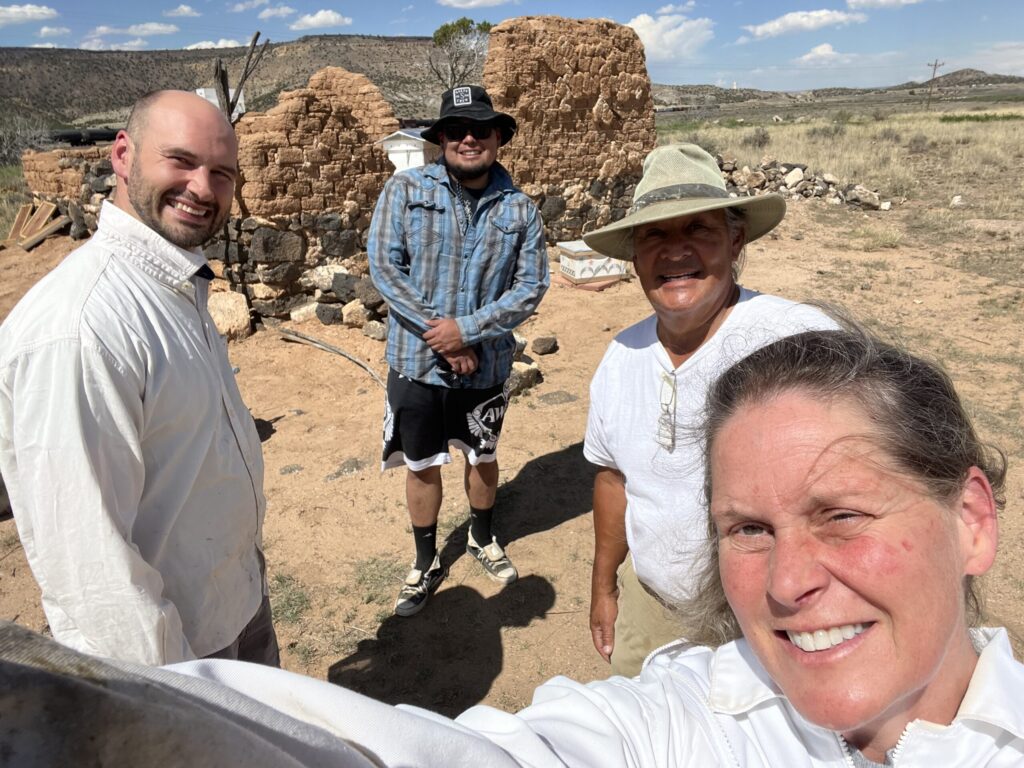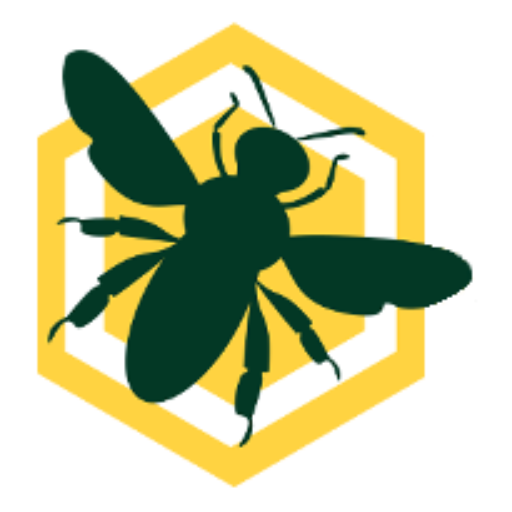This is our first interview-style blog, but we plan to share many different perspectives with you in the future. We want to showcase how the APHIS National Honey Bee Survey impacts the beekeeping community in different areas of the country and want to invite you along for the ride.
Earlier this month, we had an opportunity to talk with Anne Marie Fauvel and Ben Sallmann of the Bee Informed Partnership (BIP) about their experiences with the APHIS National Honey Bee Survey. The BIP Tech Team is made up of a traveling crew of honey bee field specialists who work closely with commercial beekeeping operations all over the US. Each survey year, BIP is contracted by APHIS to provide the inspection and sampling for states who need support in sampling colonies as part of our national effort to monitor honey bee diseases.

What states does the Bee Informed Partnership sample for the APHIS National Honey Bee Survey?
Anne Marie: We perform the APHIS National Honey Bee Survey in California and North Dakota and these are done at the same time as our regular BIP tech team monitoring services. We also do Colorado, Michigan, and Louisiana. And then each year we get a few bonus states, for example, two years ago, we sampled in Hawaii, last year we were in New Mexico, and this year in Alaska.
What is the most challenging aspect of conducting the survey away from your home base and oftentimes in remote areas?
Ben: The most challenging thing is probably just scheduling the beekeepers, getting them to answer the phone and also getting them to trust us. We’re not there to get them in trouble. We’re not there to tear them apart. We’re there to do the survey and we’re not a regulatory agency. So, getting them to trust us to get there, getting a date on the calendar, and a location, sometimes it’s like pulling teeth. North Dakota is a little different because we’re used to it and the beekeepers have been sampled many times throughout the years along with the regular tech team monitoring. They’re totally okay with the APHIS National Honey Bee Survey sampling. It is sometimes difficult to summarize the program really succinctly and sell it. But we are getting better at that.
Anne Marie: New Mexico was tricky. We did the first sampling trip in fall 2022. But that late in the season we were only able to sample in the southern part of the state through Albuquerque. We couldn’t go north at all as the upper part of New Mexico is cold in November! We were hoping to do the second trip early May 2023, but their beekeeping season really doesn’t start until the end of May, so we had to push back our trip.

Do you encounter beekeepers who have no idea who the Bee Informed Partnership is, let alone the APHIS National Honey Bee Survey?
Anne Marie: Yes. In Hawaii and New Mexico for example, when I first reached out to beekeepers, I sent an email with information about who we (BIP) are and adding a link to our BIP webpage and say that we’re doing this sampling for the APHIS National Honey Bee Survey and adding a link to APHIS NHBS webpage. We add the program highlights, providing testing of colonies and the results are free. We throw out 50 emails and we might get a few responses. But from those, sometimes we will get a referral for another beekeeper and that’s how we build the schedule and trust with beekeepers. We have to start this way ahead of time because as opposed to the apiary inspectors that conduct sampling all throughout the year in their own state, we have to do a one week or 10-day trip to get all the samples done. The timing of our sampling trips is usually very short and restrictive so the logistics is a bit tight.
Have you had a funny moment when inspecting, sampling or shipping for the survey?
Ben: The funny moments are never really in the bees. It’s almost always during shipping and the different reactions you get from the postal service workers. It was just the other day we were coming back from North Dakota, Catherine (BIP Field Specialist) and I, had one more live bee box to ship out. I was in the Twin Cities and I walked up to the counter and the lady just backed away slowly. She put her hands up and I could see the fear on her face. I don’t know what I told her to feel better, but pretty much, that we do this all the time, all over the place. It’s okay, there’s a double screen here. They can’t sting you through the box. Eventually she called someone else to come because she didn’t want anything to do with the bees. She didn’t even get within reach of it. So that sort of thing happens all of the time, where the first response is no, we don’t ship that. But then almost always they will eventually ship them. It’s really funny seeing the reactions of people that obviously don’t work with bees and I don’t blame them. There’s a buzzing box that gets set in front of them and they hear bees. The adrenaline and the instincts kick in for them.
Anne Marie: I’m not allowed to go in to the post office. I’m terrible with shipping. I get all stressed out and frustrated, even for regular shipping of packages. Ben is the designated shipper. I’ll do other things to make up for it. I’m a little too impatient. Ben is the right person for the job. We did get a refusal once, but the person had a really good point. It was a really tiny post office on a reservation (pueblo) in New Mexico. The bees would have been sitting on the tarmac all weekend and they would not have gotten picked up so they would not take that responsibility. One other time I did two (samples) in Michigan and I went to my post office because I know the guy and I thought I could handle his reaction. It was a total non-event. He said nothing. Finally, by the end I asked if this was the first time he had to ship bees? He said we get live bees all the time.
Ben: (laughing) Yeah, I bet there’s a guy called Ben that comes in all the time to ship bees. That’s the sort of thing that happened in North Dakota. I was with Kim (BIP Field Specialist) and I was telling her all about what to expect with tiny post offices and that sometimes they’ll refuse them. That you have to be ready for anything. And so, we walk in and I’ve never seen a post office worker so nonchalant. He didn’t say a word.
Have you ever had to take live bee boxes into restaurants and hotels?
Anne Marie: I’ve never brought them into a restaurant. Oftentimes we’ll leave them outside, in the shade under the truck. I have this fear that we’re going to forget and back up and squish them all. I always worry about that so I make sure to push them to not be under the wheel just in case.
Ben: I was talking to Rob (BIP Field Specialist) about having them in the hotel room next to his night stand. He was hearing (the bees) nibble on the sugar all night long, and making noise. He had dreams about creepy crawling insects that night.

When you go out for a sampling, do you meet any of the beekeepers? Do they come out and meet you?
Anne Marie: We meet a lot of them. Most of our regular BIP beekeepers let us sample without them but generally APHIS participants meet with us, like in Hawaii and New Mexico. Beekeepers have many different reactions to the National Honey Bee Survey. Some are super excited and extremely thankful that we’re doing this. And then you have some that are very leery and don’t even want to give out their email. In New Mexico, we went on a Native American reservation (called Pueblo in NM) to take a sample. It was really fantastic and a highlight of my trip there. They were one of the most unique beekeepers I’ve ever met because they had a different perspective on bees and their relationship with them. Their colonies were set on old settlement in the ruins of a foundation. It was a really cool place to be.
Ben: Yeah. We meet the beekeepers and overall, it’s positive. The one thing I don’t really like to do in front of the beekeeper is the frame bump. When they see us slam the frames down, a lot of them take it personally. For some beekeepers, every bee and every frame is precious. When they see us smack the frame and larvae popping out, they don’t really like that. Most of them don’t say anything, but I can tell. In the past, I have had a beekeeper refuse to be sampled because of the frame bump test. We preface the test with an explanation of why we’re doing it, to monitor for the invasive Tropilaelaps mites. We explain why it’s necessary.
Anne Marie: It is true that it can be difficult for the beekeeper, but the frame bump test is a good way to educate the public on the threat of Tropilaelaps, which is of elevated interest right now.
How does BIP leverage data from the APHIS National Honey Bee Survey in their own programs?
Ben: The state maps (https://research.beeinformed.org/state_reports/) and virus maps (https://research.beeinformed.org/state_reports/viruses/) on the website are pretty interesting to the commercial beekeepers that are in the tech team program. Some of them are really into looking at comparisons and they’ll dig around in the data.
Anne Marie: When we sample states for the APHIS National Honey Bee Survey where our BIP commercial beekeepers are, it’s nice to be able to offer them a pesticide sample and viral sample (both part of the APHIS National Survey). And, in states where the BIP tech team doesn’t visit, it’s good to spread the word about BIP and what we do. The BIP Sentinel program also uses APHIS National Honey Bee Survey data on their reports for comparison.
Ben: We use APHIS data during our fall conferences when we talk to our BIP commercial beekeepers about their disease levels and compare them to the National averages from the APHIS data. I think it would be interesting to get some of the viral information to get a good baseline for viruses also. APHIS has a lot to offer in terms of viral data and that would be really cool.
Are there improvements to the APHIS National Honey Bee Survey or reporting that you’d like to see?
Anne Marie: It can be really hard to sell the program because the reports take a while to get back to the beekeepers. We do make it clear that this is not like the BIP tech team sampling for which we turn around reports really quickly. In order to make up for that in Hawaii, Ben and I did alcohol washes to check for Varroa in the field. What if we could share the inspection notes with the beekeeper right away? BIP uses an app to record data and everything is uploaded instantly. If the apiary inspectors did that too for the APHIS survey, then the beekeepers could be sent an inspection report within a few days.
(Author’s Note: We’re currently working on making the app accessible for the APHIS National Honey Bee Survey and will be asking a few states to be “guinea pigs” before we launch it for the 2024 survey year!)
